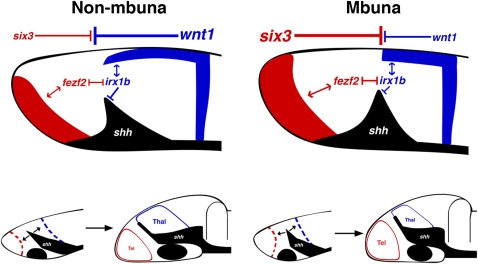Fig. 4.
Brain diversity develops at the boundaries. A model summarizes the evolutionary developmental differences between nonmbuna and mbuna forebrains. At stage 10 (Upper), the allocation of forebrain structures is determined via the competing influence of posteriorizing factors from the MHB (e.g., wnt1, shown in blue) versus WNT antagonists expressed from the ANR (e.g., six3, shown in red). This in turn sets the position and angle of the presumptive ZLI (black). In nonmbuna, posterior factors dominate the forebrain, establishing a greater (i.e., more obtuse) ZLI angle relative to mbuna. This results in the differential allocation of cells to anterior versus posterior forebrain compartments. During subsequent stages 11–16 (Lower), the initial difference in ZLI angle set during early patterning persists, with the consequence of a smaller telencephalon (tel; red) but larger thalamus (thal; blue) in nonmbuna versus mbuna.

